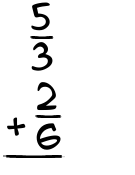What is 5/3 + 2/6?

|
This is how you add
|
||||||||||||||||||||||||||
Step 1Our denominators (bottom numbers) don't match, so we can't add yet. Since 3 is evenly divided by 6, we can multiply just one term to get a common denominator. Multiply 5 by 2, and get 10, then we multiply 3 by 2 and get 6. So now our fractions look like this:
|
||||||||||||||||||||||||||
Step 2Since our denominators match, we can add the numerators. 10 + 2 = 12 So the answer is:
|
||||||||||||||||||||||||||
Step 3Last of all, we need to simplify the fraction, if possible. Can it be reduced to a simpler fraction? To find out, we try dividing it by 2... Are both the numerator and the denominator evenly divisible by 2? Yes! So we reduce it:
Now, try the same number again. Nope. Try the next prime number, 3... Are both the numerator and the denominator evenly divisible by 3? Yes! So we reduce it:
Now, try the same number again. No good. 3 is larger than 2. So we're done reducing. Congratulations! Here's your final answer to 5/3 + 2/6
|